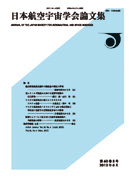巻号一覧

42 巻, 484 号
選択された号の論文の4件中1~4を表示しています
- |<
- <
- 1
- >
- >|
-
衛星を中心とした岡田 和男1994 年 42 巻 484 号 p. 273-289
発行日: 1994/05/05
公開日: 2010/12/16
ジャーナル フリーPDF形式でダウンロード (14266K) -
伊藤 健, 種子田 裕司1994 年 42 巻 484 号 p. 300-308
発行日: 1994/05/05
公開日: 2010/12/16
ジャーナル フリーSidewall compression type inlet models for the Scramjet engine were tested in NAL's hypersonic wind tunnel at Mach 7.1. Its contraction ratio, sweep angle, entrance Mach number and cowl size were set in variable manner along the experimental plan. The inlets were investigated with the flow visualization and pressure measurement techniques. As results, without the sweep angle the pressure near the open side was less than near the body side due to the spill from the inlet. It had agreement with the 2-dimensional calculation near the body only. With the sweep angle 45 degree, the lower pressure region due to the spill became small and the performance was higher. The some kinds of the flow field in the inlet owing to the variation of the configuration and basic data of the sidewall compression type inlet were obtained.抄録全体を表示PDF形式でダウンロード (14696K) -
山脇 功次1994 年 42 巻 484 号 p. 309-318
発行日: 1994/05/05
公開日: 2010/12/16
ジャーナル フリーThis paper discusses the satellite based navigation which is applicable for the guidance of space-crafts flying near the moon and positioning of vehicles moving about the surface of the moon. Several geosynchronous satellites are supposed to be used as range-finding signal sources because the suitable deployment, precise orbit determination and clock correction of these satellites must be performed for accurate navigation. This paper also studies a method of the user's clock synchronization which is useful for the improvement of navigation accuracy, and suggests that the use of very high stable clocks to user equipments is effective for the reduction of frequencies of bi-directional communications by which user's clock synchronization with the satellite's clock is performed.抄録全体を表示PDF形式でダウンロード (19962K) -
石川 隆司, 林 洋一, 松嶋 正道1994 年 42 巻 484 号 p. 319-328
発行日: 1994/05/05
公開日: 2010/12/16
ジャーナル フリーCompression after impact (CAI) tests are conducted for stiffened panels made of carbon fiber (CF)/epoxy and CF/PEEK composite systems. Delaminations between skin and stiffeners are created by impact with various energy levels. Relationships between normalized impact energy levels with respect to thickness and delamination area are obtained through a robotic ultrasonic C-scan system. Compression tests are conducted with the aid of moiré-topography camera and multi-channel acoustic emission analyzer. CAI strength of a CF/PEEK panel is superior to those of CF/Epoxy panels. In the CF/PEEK panels, delamination propagation is well arrested just by the instance of catastrophic failure, and hence, high CAI strengths are obtained. In the CF/epoxy panels with a current skin of low axial stiffness, delamination propagation between skin and stiffeners is well arrested after initial separation onset. Hence, their CAI strengths are higher than those of thick plates where delaminations easily propagates transversely to loads. Initial buckling stresses are numerically obtained through a FEM code. Some factors are crucial for accurate predictions. Stress dependency of longitudinal elastic modulus of unidirectional CFRP is the most important point. For relatively short panels used here, delicate consideration of loading edge boundary conditions is required. Consideration of realistic initial imperfection slightly improves correlation between prediction and experiments.抄録全体を表示PDF形式でダウンロード (19062K)
- |<
- <
- 1
- >
- >|